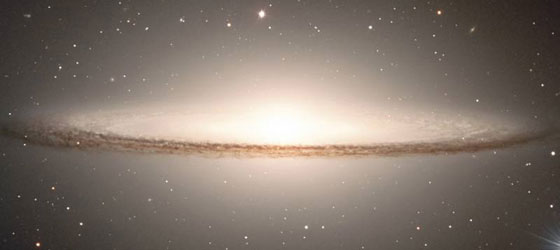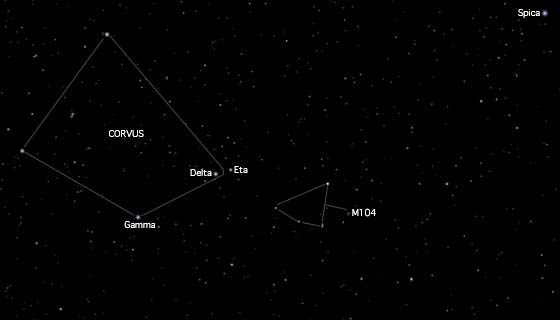
M104Basic information about M104. Its a spiral galaxy (type Sa-Sb), in Virgo, also known as NGC4594 or the "Sombrero Galaxy". Its position is right ascension 12:40.0, declination -11:37. The distance is 50 million light years. Its magnitude is 8, the apparent dimensions are 9x4 arc minutes with a dark lane 15 arc seconds wide south of the nucleus. We see the galaxy almost edge-on from Earth, the tilt is just 6°. This was one of the first galaxies found with a redshift big enough to show it was not part of our galaxy. the recession speed is about 1000 km/s. On long esposure photographs several hundred globular clusters can be seen orbiting the galaxy. An easy object, visible in binoculars and small telescopes. The location is quite easy using the constellation Corvus as a starting point. A 20 cm telescope will show the dark lane with the bright haze of stars on either side. 
The drawings above show some views of the galaxy through 4 inch to 12 inch telescopes and moderate seeing conditions. Not quite as spectacular as the superb image at the top of the page but the structure of the galaxy is quite clear. The dust lane and spherical glow of stars are easy, even with a small telescope. I used about 240 power to observe this galaxy. Judging by its appearance here maybe it should be called the UFO galaxy! 
To find M104 you need find the small constellation Corvus. Look for the irregular kite shape near Spica (Alpha Virginis, the 16th brightest star in the sky, magnitude 0.96, true brightness almost 15000 Suns). After finding Corvus look back towards Virgo a short distance until you find the small triangle of 5th and 6th magnitude stars (obviously binoculars are best here). Look out as a right angle from this triangle and you should see the galaxy. The chart above should make these instructions clearer. |
![[Up]](../XuShared/Up2B.jpeg)
Comment on this page: Very Useful • Quite Useful • Useless or: View Results |
||||||||||||